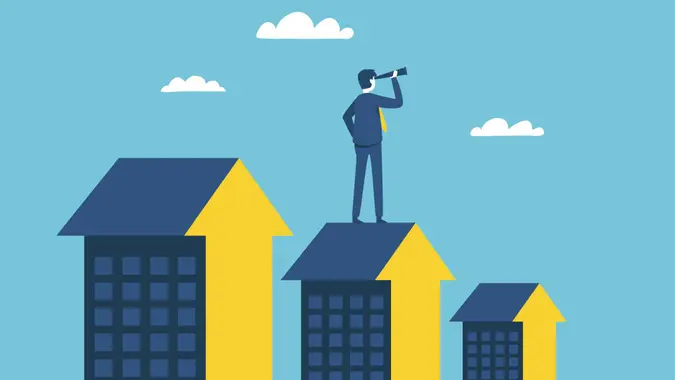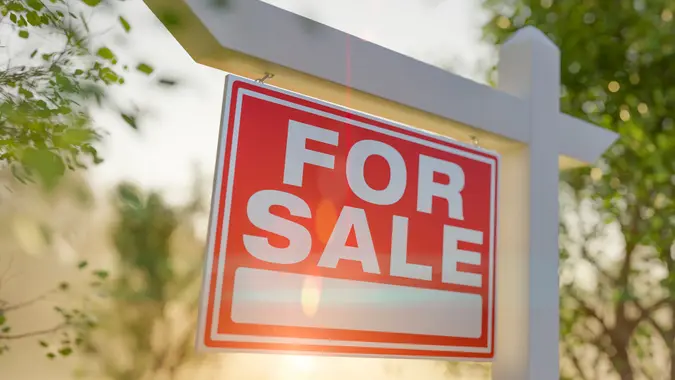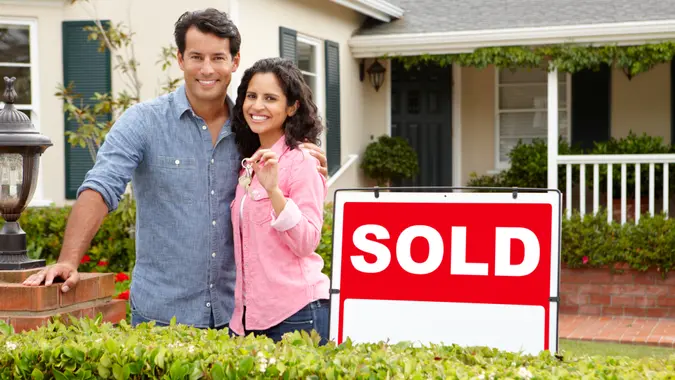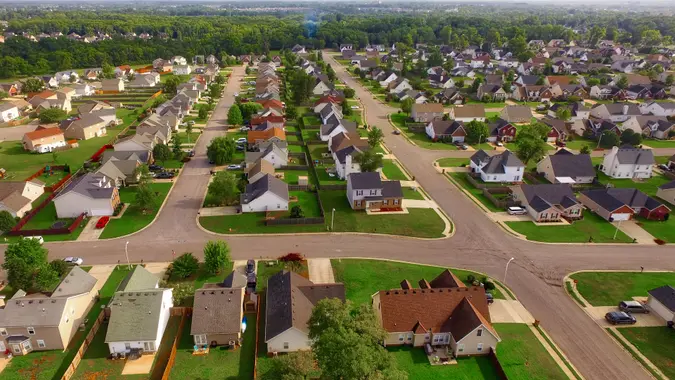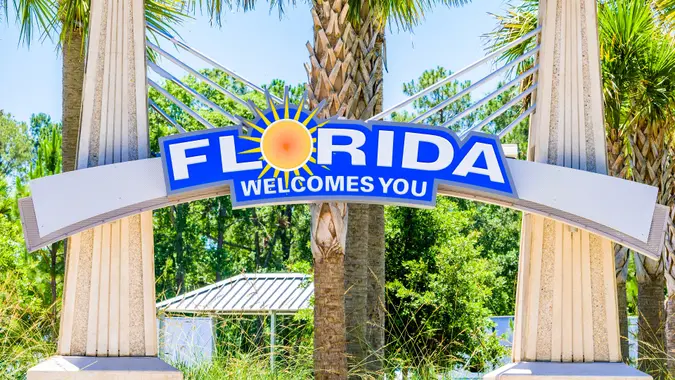How Much Does The Homebuying Process Really Cost?

Commitment to Our Readers
GOBankingRates' editorial team is committed to bringing you unbiased reviews and information. We use data-driven methodologies to evaluate financial products and services - our reviews and ratings are not influenced by advertisers. You can read more about our editorial guidelines and our products and services review methodology.

20 Years
Helping You Live Richer

Reviewed
by Experts

Trusted by
Millions of Readers
Saving for a down payment on a home is a huge step in the home buying process. A sizable down payment can help with mortgage prequalification or mortgage approval — however, it’s not the only cost associated with buying a home. Many people who are buying a house are surprised to find out that there’s a whole world of fees, taxes and ongoing expenses waiting for them during and after the process of securing a loan and a deal. Over time, the total cost of ownership can easily end up being more than double your original purchase price once you factor in all expenses.
It’s a good idea to get ahead of the curve early in the home buying process and know what you should look out for throughout the transaction and beyond. In addition to the common, obvious costs like your home mortgage, there can be a lot of little fees that add up to a significant amount of money when you buy a house, so it’s best to be prepared ahead of time. Although most homebuying costs — aside from loan origination fees — can’t be negotiated, some first-time home buyers and seasoned professionals alike will try to get sellers to pay for some of them.
So that you can better figure out your financial planning when buying a home, here’s a list of common fees to expect when buying a home. With this list as a starting point, you’ll be able to get a more accurate estimate of how much money you’ll need throughout the homeownership cycle.
Find Out: When to Make the Leap from Renter to Home Owner
Down Payment
A down payment serves two main purposes when buying a home. First, it builds immediate equity in the home and reduces an owner’s monthly mortgage payment. Second, it acts as security for mortgage lenders, as they take on less risk of extending loans when there is already equity in a home.
Historically, the “standard” down payment amount has been 20% of a home’s price. Not only does this provide for a safe equity buffer in case housing prices turn down, it also protects buyers from having to pay for private mortgage insurance, or PMI. However, down payments as low as 3% are available with certain types of loans offered by government agencies like Fannie Mae.
Here’s how a down payment works. Imagine that you’re purchasing a home for $350,000. A 20% down payment would run $70,000, while a 3% down payment would cost just $10,500.
Closing Costs
Let’s get the good news out of the way first — typically, a seller is the one who has to pay the real estate commissions for both the buying and the selling agents. As these can run as much as 6% of the cost of the entire transaction, they are a sizable expense that most buyers don’t have to worry about.
However, buyers are responsible for paying a variety of closing costs on a home transaction. Closing costs are expenses that are necessary to process and complete a real estate transaction. According to The Mortgage Reports, closing costs average somewhere between 2% and 5% of your loan amount.
Common closing expenses include the following:
- Loan origination fees, 0-1% of loan amount
- Underwriting fee, $300 to $750
- Home inspection fee, $300 to $500
- Appraisal fees, $500 to $1,000+
- Title insurance, $300 to $1,500+
- Credit report fee, $35
- Processing fee, $300 to $900
- Escrow fee, $350, to $1,000+
- Recording fee, $20 to $250
- Prepaid taxes and insurance, $1,000 to $4,500+
While these are common closing fees, they may differ based on several factors, such as your location and the companies you work with.
Ongoing Homeownership Expenses
After you pay your closing costs, you’ll have annual and ongoing expenses to manage. Here’s what you should expect.
Mortgage Payments
Most homeowners understand they’ll have to pay monthly mortgage payments. But in most cases, you’ll pay much more in interest every month than you will in actual principal. In other words, if you have a $3,000 monthly mortgage payment, it doesn’t mean that $3,000 goes toward paying down your principal balance. Depending on the terms of your loan, only a few hundred dollars of that $3,000 may end up going toward your outstanding balance for the first few years, with the bulk going toward interest.
Imagine, for example, that you take out a 30-year fixed mortgage loan for $300,000 with an interest rate of 6.5%. Your monthly mortgage payment will be $1,896.20 throughout the life of your loan. But for the first month, you will only pay $271.20 towards your principal balance, with a whopping $1,625 going towards interest alone.
The longer you continue to make payments, the greater the percentage of your monthly payment that will go towards your principal. But still, in the above example, it will take you nearly 20 years of payments until your principal and interest payments will be roughly equal.
The terms of your loan determine the mathematics of that equation. With a shorter term and/or a lower interest rate, you’ll pay less in interest and more toward your principal. This is why it’s essential to get the lowest mortgage rate you can find. You may also consider making additional monthly principal payments or financing over a shorter time period to reduce your interest outlay.
Property Taxes
Property taxes are another significant expense for homeowners. They can vary considerably based on where you’re located.
According to the Tax Foundation, property tax rates can run from as low as 0.26% in Hawaii to as high as 2.08% in New Jersey. This percentage is applied to the assessed value of your home as determined by your local county.
On a $400,000 home, this means your annual property tax bill can range anywhere from approximately $1,040 to $8,320.
Homeowners Insurance
Your home is likely the biggest purchase you will ever make. As such, it is critical to protect it with homeowners insurance. A good insurance policy protects you from damage, such as a rock going through your window, to loss, such as your property being stolen or burned by fire. It can also insure you against liability claims from others who are harmed on your property.
Most homeowners insurance policies cost between $1,100 and $2,100, according to Progressive. Of course, this price could vary dramatically based on the value of your property and the type of coverage you select.
Maintenance and Repairs
To keep your house in good working order, you should budget for annual maintenance expenses. Whether it’s getting new carpet or windows, replacing worn-out furnishings, or just keeping your place clean, your annual maintenance costs generally run about 1% of your total home’s value. However, insurer State Farm suggests that you may need as much as 4% annually to care for your home.
Additional Costs To Consider
But wait! The list of potential added expenses isn’t complete just yet.
Private Mortgage Insurance (PMI)
Private mortgage insurance is typically required when a buyer puts up a down payment of less than 20%. PMI protects mortgage lenders from default, which is a greater risk when there is less equity in a home.
Different lenders charge different PMI rates, but you should expect to pay between 0.5% and 1.5% of your loan value, according to The Mortgage Reports. This is added to the principal and interest you’re already paying in your monthly mortgage.
Homeowners Association (HOA) Fees
Not all homeowners have to pay associate dues, but many due. A home association is an organization that helps manage collective assets of condos or homes, enforcing rules, collecting dues, and generally contributing to the overall welfare of the association members. As with home prices themselves, HOA fees can vary dramatically based on the location and needs of the members. Most HOA fees run a few hundred dollars per month, but some can cost $1,000 or more.
Utilities and Services
Even if you’re a renter, you likely have to pay at least some utilities, so this cost shouldn’t come as such a shock as a homeowner. Be sure to include all of the following basic expenses — and likely more — in your monthly utility budget:
- Electricity
- Gas
- Water
- Trash collection
- Internet
- Other home services as desired, such as cable television or a home phone line
Regional Variations in Home-Buying Costs
You’re likely familiar with the expression that location is everything when it comes to real estate. This is demonstrated by looking at just how dramatically home prices vary across the country. For example, while the average home price in Arkansas is about $209,000, according to Zillow, it’s $774,347 in California. And those are not even the most and least expensive housing markets in the country. Since your home price is the basis on how much you’ll have to pay for other expenses, from your property taxes and insurance premiums to the amount of interest you have to pay every month, it’s a huge consideration.
If you’re looking to trim your housing budget, consider starting in a more affordable area. This doesn’t even necessitate moving to another state unless you are so inclined. Rural areas, for example, are typically cheaper than urban areas. Inland regions similarly tend to be more affordable than coastal ones.
Tips for Managing Home-Buying Expenses
The lower you can keep your expenses, the more house you can get for your money. Here are some strategies to make your dollar stretch further.
Budgeting and Saving Strategies
You should develop a homebuying budget before you go out and look at actual homes. Between pressure from agents and the “wow factor” buyers often get from seeing homes firsthand, it’s entirely likely that you’ll end up pushing your budget beyond what you can really afford if you haven’t established it beforehand.
Long before you get to the “shopping around” phase, however, you should set up a solid savings plan. Open a high-yield savings account that pays a high rate of interest, is insured, and is completely liquid. Set up automatic transfers from your checking account — or even from your paycheck — to this savings account, and don’t touch it for any purposes until you’re ready to use it for a down payment.
Exploring Financial Assistance Programs
There are numerous homebuyer assistance programs that can help you with grants or even down payment assistance. This is particularly true for first-time homebuyers. Typically, these types of programs are more generous or even only applicable to lower-income earners. However, there are so many programs available that you should check with federal, state, and local agencies to see what you may qualify for. To cite just one example, the Santa Ana Down Payment Assistance Program in California provides no-interest loans of up to $40,000 to help some homebuyers make a down payment.
Shopping Around for Mortgage Rates
As with any financial transaction, it pays to shop around for both a mortgage lender and an escrow company. As lenders offer different mortgage rates and escrow companies charge different fees, you’ll want to find the right combination of service and value. Especially if you’re not familiar with the home buying process, having the right agent, lender, and escrow company can help you save money.
Key Things to Watch for When Buying a House
With the eye-opening average cost of a home across America these days, it’s more important than ever to understand that the sticker price of a home is far from the only expense you’ll face. For this reason, it pays to take the time to plan and budget carefully long before you start the process of actually shopping for homes. As the ins and outs of homebuying can get quite complex, it’s a good idea to consult with financial and real estate professionals early on in the process. When you’re prepared, then homebuying can become the dream you want it to be.
 Written by
Written by  Edited by
Edited by 





